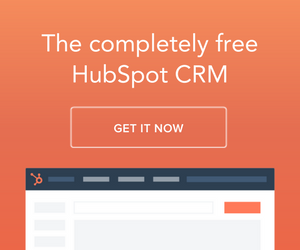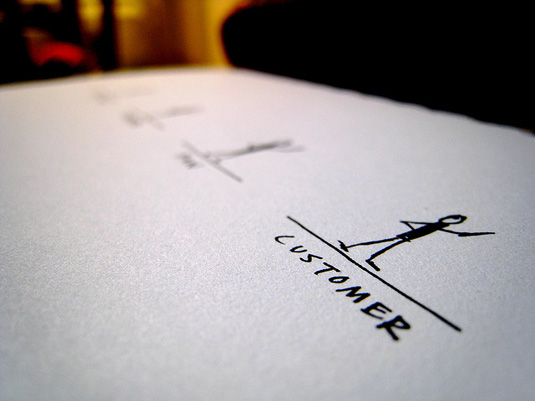 Customer experience. It’s what separates the great businesses from the hacks. The happy customers from the angry and frustrated. It’s the moment of truth.
Customer experience. It’s what separates the great businesses from the hacks. The happy customers from the angry and frustrated. It’s the moment of truth.
The second a prospective customer decides to interact with, and potentially buy from, your business, you’re officially on the clock.
Every interaction and touch point matters. You want (need) to create an experience they’ll not only remember, but one that will ultimately lead to a sale and their repeat business. That’s the obvious part. But to get there, you need a plan—a strategy built around customer experience best practices.
Recently I had a chance to speak with Lynda Smith, chief marketing officer of San Francisco-based Twilio, a software and cloud communications platform company, about the customer journey during their “Engineering The Customer Experience Roadshow.” Here are the top customer experience strategy best practices.
Map customer experiences from end-to-end
What should that very first interaction look like? What about what happens after they make the purchase? Do they have a smartphone? Answers to those questions will go a long way in helping you craft your strategy. “You work hard to draw visitors to your store, get people in the door, and make a purchase,” said Smith. “Mapping the customer experience from end to end helps make their buying experience one they’ll remember,” she added.
Don’t overlook the small things—including how (and who) answers the phone. Anticipate potential questions and requests and develop a plan to make sure your staff has the right resources, training, and technology to help.
Focus on every customer interaction
I’ll never forget the time I called a local pizza shop and asked for any recommendations from the person who answered the phone. “I’m not sure. I have a flour allergy.”
Read More >> Setting Customer Expectations (Without Totally Blowing It)
Besides her questionable career choice of deciding to work at a pizza shop with a flour allergy, she totally blew it. Instead of focusing on a negative, she could have just as easily shared recommendations based on customer feedback. She was on the front lines. Our only interaction with that business. And not surprisingly, we haven’t been back.
Provide exceptional customer support
Customers are going to have questions. They’re going to need support. Support that’s personalized, friendly, and professional.
Zappos built an empire on it.
Think back to the customer experience mapping mentioned above. Do you make it easy for someone to get in touch with your business if they have questions? Or do you bury your phone number in the footer of your website or way down on your contact page? Do you acknowledge receipt of their inquiry? Do you follow up in a timely fashion (within 24 hours at the absolute latest).
Finally, don’t assume the customer experience ends once someone makes a purchase. Depending on your product or service, that could be the beginning of their journey.
Maximizing the customer experience “moment of truth”
How do you interact with your customers? Where can you create a better experience? “It’s all about the moments of truth. Once you’ve got their attention, what are you going to do with them?” A parting question from Smith that all businesses need to answer.
Share your thoughts in the comments below.
[Image: Flickr 10ch]
 Give someone a branded stress ball, and your business will be remembered until that stress ball gets thrown out in the hotel room trash.
Give someone a branded stress ball, and your business will be remembered until that stress ball gets thrown out in the hotel room trash.
Create a memory and a unique experience and that’s when you have something special--a meaningful connection that could turn into a potential client or strategic partner.
When done right, trade shows can be an incredibly effective place to generate brand awareness, meet new contacts, and showcase your latest and greatest products and services.
But your success starts long before you arrive at the convention center or hotel ballroom with your spinner and the massive display that’s part origami, part mechanical engineering project.
If you want to make the most of your trade show spend, you need a plan leading up to, during, and after the event.
Marketing before a trade show
Start to let current and prospective clients know you’re going to be going to be exhibiting at XYZ trade show approximately 45 days out. This can include personal interactions, mentions in email newsletters, and via social media (make sure to include any relevant hashtags).

You also want to monitor your social networks for mentions from contacts about attending the trade show and follow up where it makes sense.
Always look for opportunities to schedule appointments (dinner, coffee, etc.) with partners, stakeholders, and customers during the show. Also think about other businesses and people you want to meet ahead of time. That way you can do some background research and make the most of your time during those initial interactions.
Of course it wouldn’t be a trade show without thinking about your booth—what promotional items make the most sense and most importantly what’s going to help get your business noticed.
It’s okay to be creative and cute with your display, you just want to make sure it’s relevant to your business. John Greathouse profiles how Central Desktop was able to employ a cigar-smoking, bearded angel with an exaggerated New York accent to get some amazing buzz during the San Francisco ad:tech conference in an article for Forbes—definitely a must read for any trade show exhibitor.
The halo? The harp? Tied directly to their move to the cloud? Brilliant.
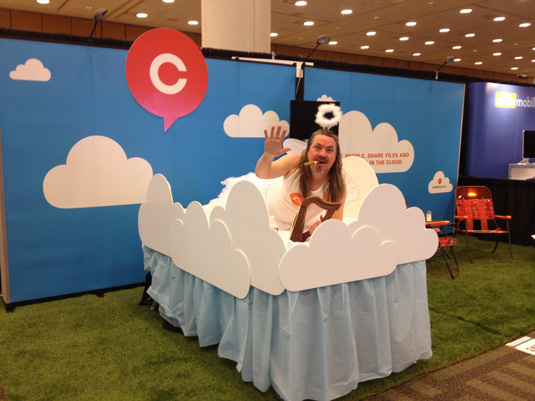
You’ll also want to check out this article from John on another creative trade show marketing success story.
Marketing during a trade show
I know it can be exciting for some to be away from the family, stay up late, and throw back a few too many cocktails. Remember why you’re there—to meet prospective clients and promote your business. That means you should be easily approachable any time you’re at your booth, mingling with colleagues, riding in an elevator, etc.
And speaking of booths and approachability, those uncomfortable folding chairs are not your friends. If you’re physically able, make sure you wear some sensible shoes, stand up, and get away from behind the table to eliminate any unnecessary barriers to conversations and personal connections.
Notice the focus on personal connections. Collecting hundreds of business cards in a fishbowl doesn’t mean anything if you’re not going to do anything with them. Remember you’ve likely spent a significant amount of time and money on travel, booth fees, displays, promotional items—don’t let your investment go to waste.
Marketing after a trade show
Follow up with relevant contacts. I know that sounds obvious, but you’d be surprised at how many times businesses never get around to what’s arguably the most important outcome from the trade show. If a connection is local, find a time to meet over coffee or at their location so you can build upon the dialogue that started during the event.
In addition to individual follow up, consider generating some content attendees (and those who were unable to make it) would find helpful. This could include a recap, insights into emerging trends, observations, or even responses to questions you received during the event. Content is a great way to drive prospective customers and clients back to your website and also expand your reach to others who find the post online after the trade show.
ExactTarget always hits content out of the park around their Connections conference. Here’s a quick snapshot of some of the creative articles from last year’s event. Something like “The Top 10 Tweet-Worthy Moments” and “The Survival Guide to Connections #ET13” could be a great fit for any trade show.

Above all, maximizing your trade show spend requires a plan that reflects your unique value proposition and the personality of your business AND one that will resonate with potential clients.
It’s okay to employ a cigar-smoking, bearded angel with an exaggerated New York accent—but you better make sure there’s a clear connection with your brand. If not, you could have just saved your money and ordered some of those stress balls.
Looking for more trade show marketing tips? You’ll love this post >> The Inbound Way to Do Trade Show Marketing.
[Images: Flickr user Trisha Fawver and Central Desktop]
 When it comes to your small business website, there’s a big difference between generating traffic and generating the right traffic.
When it comes to your small business website, there’s a big difference between generating traffic and generating the right traffic.
You can get tons of hits, but if those hits aren’t coming from your target market you’re going to struggle to attract new customers.
How can you get more targeted traffic?
Analyze Your Numbers
Before you can focus on getting more targeted, you have to understand your current traffic—the people who are already visiting your site.
Google Analytics and Google Webmaster Tools are two incredibly powerful tools that can help you gain insights into your most/least popular pages and blog posts, which social media platforms are driving the most traffic to your site and--most importantly--your relative ranking when it comes to specific search queries.
When I review search queries in Webmaster Tools (under “Search Traffic” in the menu on the left side of the page) with small businesses, they’re almost always surprised at the words and phrases they’re ranking for—and the words and phrases they’re not.
Once you have a chance to look at your data, then you can start to dig in and look for opportunities to focus on different keywords and phrases based on your specific target audience.
Both tools are free and are a definite must have for any small business website.
Think Like Your Customers
I know it sounds obvious, but it’s the key to ultimately generating more targeted traffic. Who are they? Where are they? What questions do they have? What types of information and content are they looking for?
A great example is this post by a personal injury attorney I saw earlier this week. The blog was about the best off-leash dog parks locally—helpful information for dog owners and something that generates brand awareness if the unfortunate happens and you were to get bit by an off-leash dog at one of those dog parks.
Start by identifying 5-7 themes—topics you think are most relevant to your target audience and then make sure you’re addressing those questions on your site.
Where appropriate, incorporate keywords and phrases into your pages and blog posts—the keywords and phrases you want to be known for. If you’re in a highly competitive space (and who isn’t?), think about longer phrases—3 to 5 words (ex. industrial cabinet hardware) versus trying to generate targeted traffic around a specific keyword (ex. hardware).
Whatever you do, just don’t overdo it. If you try to over-optimize your content and incorporate the same phrases over and over again, you’ll get dinged by search engines. Instead, keep in mind the words and phrases you want to be known for and look for opportunities to incorporate them into your content naturally.
Generating more targeted traffic requires having the right strategy in place. Start by assessing who is already coming to your site and why and then use those insights to drive your content and messaging going forward.
There are other strategies and tactics, including email marketing, that we’ll cover in future updates. So stay tuned.
P.S. If you enjoy my small business marketing tips, I hope you’ll share my blog with colleagues.
By: Shawn Graham
[Image: Flickr user Eran Sandler]
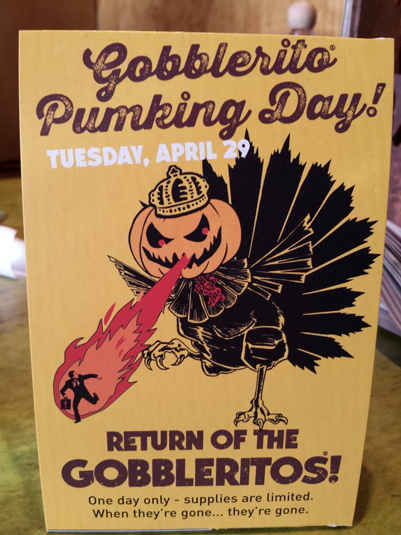
They build anticipation and excitement. They give your customers a reason to shop at your small business or restaurant on one specific day out of the week, month, or year.
When done right, one day only specials can be an incredibly effective way to generate buzz and drive sales.
But you don’t have to wait for Presidents Day, Black Friday, Cyber Monday to make a splash. In fact, it’s better if you don’t.
The Return of the Gobbleritos
Wait…what? Gobblerito? What the heck is that?
Think Thanksgiving dinner in a burrito. It was created by the folks at Mad Mex, one of my all-time favorite local restaurants.
They totally made it up and it’s something they roll out at different times throughout the year.
Read More > Retail Psychology: Why Shoppers Can’t Resist a Sale
It’s not a regular menu item. And that’s the key. That’s what helps build anticipation. In fact, they roll it out at times when Thanksgiving dinner is the farthest thing from your mind. Almost counterintuitive. And people line up.
Mad Mex does a lot of things well when it comes to marketing and “The Return of the Gobbleritos” is no exception.
They created a custom Facebook cover photo…
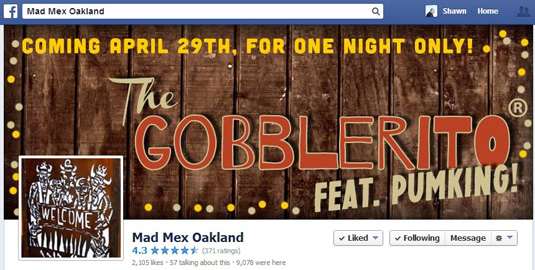
and used social media to promote the event a few weeks out and the day of (notice the relevant hashtags)…

They used table tents and signage to spread the word to patrons. And people line up.
Read More > Why Small Businesses Still Need Old School Marketing Tactics
Beyond creating buzz with a one day only special, they really do a great job of messaging. Take another look at the table tent pictured at the top of the post.
First things first—it’s going to grab your attention. A giant turkey with a pumpkin head (a cross promotion with Southern Tier Pumking Drafts). The turkey is breathing fire—enough to pull anyone in.
But there’s more.
“One day only.”
“Supplies are limited.”
“When they’re gone…they’re gone.”
Even if you had no idea what a Gobblerito is, I’m going to guess that messaging is at least going to make you ask. And that starts a conversation. Which is exactly what every marketer wants.
If you’re looking for ideas, try Googling obscure holidays to see if there’s anything that fits with your small business, your products, and your brand. Consider putting a different spin on an existing product or service. And above all—get excited. Your customers will notice.
Think about your small business and your B2B or B2C products. A one day only special can work whether you’re selling Gobbleritos, industrial cabinet hardware, t-shirts, or lawn mowers.
How might you be able to use a one day only special to generate more customer traffic?
Share your thoughts and questions in the comments below.
By: Shawn Graham

How well does your online marketing measure up against the competition? Do you know? When was the last time you actually checked?
One of the best ways to evaluate the effectiveness of your online marketing strategy is to see how your tactics and messaging compare to your competitors.
Benchmarking is at the heart of every one of my client engagements. It’s a way to identify specific and tangible examples and suggestions to help you make improvements and/or validate the things you’re already doing right.
What’s the best way to compare your local marketing against your competitors?
Identify your top three competitors
Who are they? Why are they on your list? You might find it hard to narrow down to only three in the beginning, but typically that’s going to make it so much easier for you to do some in-depth analysis.
Review their websites
Unlike a brochure or other print materials that can be difficult to get your hands on, websites are readily available and can provide a direct window into their marketing soul.
Be subjective. Try to take a step back and look at everything through the eyes of a prospective customer.
Is there anything that jumps out on their homepage? Think about first impressions. It could be their logo, their tagline, their navigation, etc. What are their key messages (ex. “Established 1975” or “Your hometown….”) and how do they compare to yours? Are they using images to showcase products and services effectively? What else could they improve?
Google your business
Use search terms you think customers would use to find you online.
When your business pops up, compare your meta description—the little blurb of text that appears under your business name and link on the results page.

Is your meta description more persuasive than your competitors? Less persuasive?
How can you make improvements to increase the likelihood that someone will actually click on your link?
Of course we can’t talk about Google without talking about SEO (search engine optimization). When it comes to your business being seen in the search results, you need to make sure you have all of the right blocking and tackling in place. This ecommerce SEO 101 video series from Shopify is a great place to start.
Review their social media presence
If they’re on Facebook, how are they using their cover photo to highlight their offerings? What types of content are they sharing (and how often)? Are people commenting and sharing their posts with others?
Don’t mistake social media “activity” for action. I see a lot of small businesses fixate on how many “Likes” or “Followers” they have on Facebook and Twitter—but ultimately neither of those mean anything if the “Likes” and “Followers” aren’t getting your phone to ring or getting people to buy your products.
Review online directory listings
Positive reviews on sites like Yelp and Foursquare can give your competitors a huge edge. If you only have a couple of reviews, encourage customers to check you out the appropriate platforms. Just be sure you follow their specific guidelines so you don’t violate any terms. With Yelp, for example, you can’t ask customers for reviews.
Make sure you claim your business listing if you haven’t already done so. Complete all of your profile information including your hours, services, forms of payment, etc. You’ll also want to add some photos to give your profile visual interest. That way when your business does appear in search results, you’ll be way more competitive.
The Benefits of Benchmarking
It’s difficult (if not impossible) to know how your business stacks up against the competition unless you periodically benchmark against your peers.
The sources mentioned above are just a few of the many places I look when performing an indepth online marketing analysis for my clients. And those sources will also help you identify what you’re already doing well, where you can make improvements, and how you can continue to differentiate your small business and your marketing efforts from your competitors.
In other words, it’s definitely worth your time.
How do you compare your local marketing against your competitors?
Share your thoughts in the comments below.
By: Shawn Graham
[Image: Flickr user Andrew E. Larsen]
More Entries »
 Customer experience. It’s what separates the great businesses from the hacks. The happy customers from the angry and frustrated. It’s the moment of truth.
Customer experience. It’s what separates the great businesses from the hacks. The happy customers from the angry and frustrated. It’s the moment of truth.  Give someone a branded stress ball, and your business will be remembered until that stress ball gets thrown out in the hotel room trash.
Give someone a branded stress ball, and your business will be remembered until that stress ball gets thrown out in the hotel room trash.


 When it comes to your small business website, there’s a big difference between generating traffic and generating the right traffic.
When it comes to your small business website, there’s a big difference between generating traffic and generating the right traffic.




